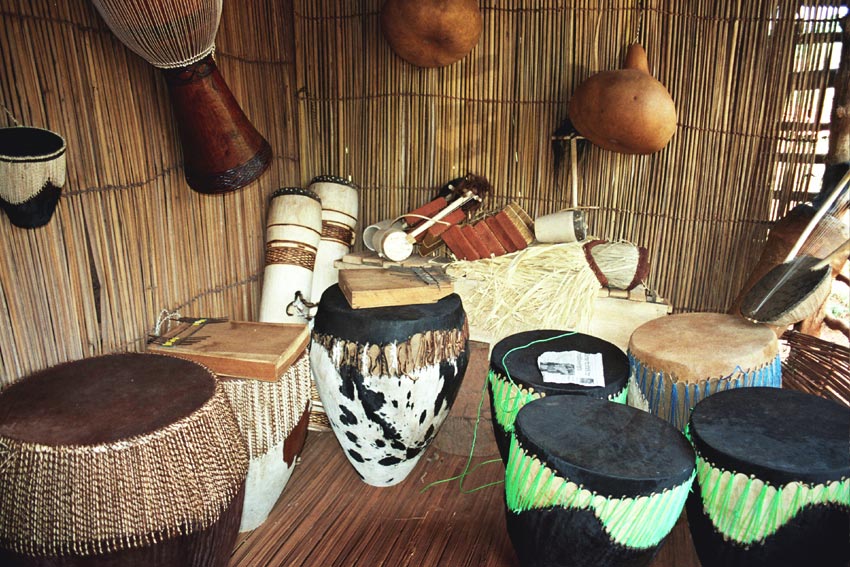
Introduction Musical instruments play an important role in Uganda communities. They contribute to the social, psychological, therapeutically and educational existence of the people. Musical instruments constitute a large portion of people’s cultural heritage and history. In day-to-day activities of people, musical instruments feature in one way or another.
Musical instruments of Uganda bear different features, belong to different classes and serve different functions. They differ in tone, quality, timbre and resonance form one community to another depending on the value attached to the instrument. Some are similar from community to community for historical reasons. They may have had the same origin or lived together for some time. This relationship is a lot noted in the instruments of the neighboring countries.
An internationally accepted classification method has been used in listing these musical instruments.
MEMBRANOPHONES
This class of musical instruments is composed of drums of varying sizes and shapes. Drums are made by fixing, tying or fastening animal skins on wooden frames. The skins may be thin, light or thick. The frames also differ in shape. These two factors combine to produce the required quality of sound.
With the modernization of technology some plastic and metallic materials have been introduced to serve as frames. Rubber is also being used in place of skins. This is not wide spread though. The traditional standards are still dominant.
DRUMS OF UGANDA
Drums are perhaps the most popular musical instruments in Uganda. Only small portions of Karamoja and Sebei do not use drums at all. Because of the continental predominance of drums, it is hard to trace the origins of each type of drum. The commonest method of making drums is to make a cavity in a tree-trunk after it has been cut to the size required by the drum-maker. The wood is selected form material which is not susceptible to boring insects or easy rotting. The wood is seasoned by keeping it in a place offering good conditions for a length of time to avoid it wrapping. When it is ready, some preservatives are applied to the wood and the skin. Some repellant herb is enclosed inside the frame in order to repel insects which could damage the skin and the wooden frame. Light and thin skin from crocodiles, monitor lizards (African varanidae0 or alligator are used to make cylindrical long drums of a delicate type played exclusively by hand. These types of drums are covered only on the end. Pegs are used to fasten the delicate skin onto the large shaped end of he hollowed out frame.
The relatively heavy skins of cows, goats and other animals are used to make small, medium size and big drums which are played using wooden sticks or hands. These drums are usually covered on both ends. Straps hold the membrane to the required pitch.
These drums are used for a variety of purposes.
DRUMS FOR COMMUNICATION.
Drums offer a very effective system of communication. Different patterns of sounding a drum could summon members of a particular society to convene for hunting. The messages transmitted indicated the place of assembly, the type of hunting implements to bring and the type of animals to be hunted. However, in the modern era, not many people can discern coded messages sounded on the drums or on wind instruments. Drums were also used to warn people of danger, to declare war and to summon people to assemble. Drums are still used in some areas to get people together for communal work. The work activities range from road construction or repair t group cultivation of crops. Communal cultivation is common where a lot of un-cultivated land is available.
DRUMS FOR RITUALS
Drums are used in ceremonies of installing kings, or chiefs; traditional worship, therapeutic treatment, exorcism and twin ceremonies.
In the areas of Buganda, Ankole, Bunyoro and Toro which had monarchies, the drums acquired a special status associated with royalty. Special drums were played at the birth of a royal child, at the installation of a new king and at a burial. Each occurrence and occasion had its own style of and pattern of sounding drums. These drums also acquired special names which distinguished them from ordinary types, e.g. Mujaguzo, in Buganda, bagyendanwa in Ankole kingdom and mirembe in Toro and Bunyoro.
Traditionally, drums and other special instruments for palaces were mad e by special people. These were experts and their offices were hereditary. They were honored to choose someone form among themselves to stay in the palace to look after the drums for the king. This was the practice in all kingdoms as well as in some chiefdoms. In some cases, only certain members of a particular clan were qualified to play the royal drums for different occasion. Otherwise, court-musicians were chosen on merit. They were required to declare their allegiance to the king.
Royal drums were beautifully decorated with colored beads and cowrie shells of different sizes and shapes. Their royalty could be seen in the style of decoration.
In Buganda, some of the royal drums were played using decorated bones of dead people in place of wooden sticks. The bones were decorated with beads. They were especially used to announce the death of a king. The style of playing drums on anniversaries or installation of kings varied.
Another important set of drums connected with Buganda royalty is the entega drums. These drums are believed to have been adopted by king Mulondo in about the 16th century and ordered by the king to be brought and played in the palace because of the beauty of the music these drums produce. A ruling was made then to have them played whenever the kabaka was at home, early in the morning and late in the evening. These drums ceased to be made and played elsewhere except in the palace by people from Lugave clan.
DRUMS FOR TRADITIONAL WORSHIP AND HEALING RITUALS
Drums are used in traditional worship to evoke evil spirits to bring about results. In traditional worship and healing, instruments were accompanied with special songs and dances. Both drums and the music they played were classified as sacred and could not be played elsewhere or for any other purpose. These sets of drums are: Enswezi and amayebe drums of Busoga, etida of Teso, bul jokof Lango and Acholi, Lubaale of Buganda. The dances were named after those drums. They are danced to by the healers and the clients. Many of the dancers are said to get possessed by the spirits educed by the drums. Other musical instruments associated with worship and healing were gourds; rattle (ensais in a number of Bantu languages). Although both drums and rattles are now used in other ways their sacred role is still respected especially when used for therapeutically purposes.
DRUMS FOR TWIN CEREMONIES
As soon as twins are born, they are greeted with special ululations to announce their arrival. There follows the sounding of a particular drum to confirm the news carried by the ululation.
This drum called engalabi and engaabe in Luganda and Lusoga respectively, and emiidiri in Ateso is long and cylindrical. Techniques of playing drums at twin ceremonies are distinctively different form those of ordinary dances. They vary from one ethnic group to another. The styles of dancing range from being close to familiar dances to completely unfamiliar styles tat a stranger to the tradition would classify as to obscenity. Most parts of western Uganda do not honour the birth of twins. Thus there is no apparent musical activity associated with twins. The tradition regards the birth of twins as a curse; therefore it does not deserve any celebration.
DRUMS FOR DANCES
With the exception of a small portion of Karamoja, most kinds of dance music in Uganda would be incomplete without the use of drums. Drums are responsible for differences in the dance styles. Some dances like Bakisimba and Amagunju of Buganda,Tamenha Ibuga of Busoga, Amakondere of Bunyoro and Ekizino of Ankole acquired royal status in those areas, while Bwala of Acholi and Ajos of Teso were popularized for the installation of chiefs.
In Acholi almost every home had at least one small drum for eachBwola dancer. Bwola dancers are co-coordinated by a big drum, bulduring the dance.
IDIOPHONES
This class of Musical instruments is percussive. It includes those which are struck, slapped, hit, punched, knocked, rubbed, smitten or shaken, i.e. drums, logs, xylophones, maracas or shakers (ensasi). This class constitutes perhaps the largest collection of Ugandan musical instruments. Activities like striking parts of the body, metal, wood to stamping on their ground produce percussive effects. This testifies to the spontaneity and freedom Ugandans owe to rhythm and musical sound. As may be seen, some of these temporary musical instruments are discarded after use.

 Posted in
Posted in 

